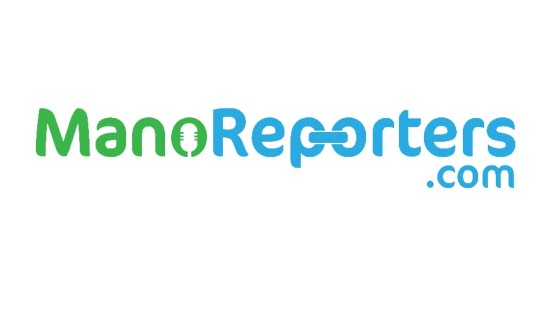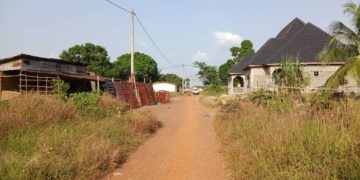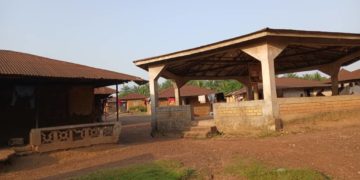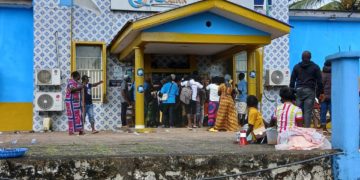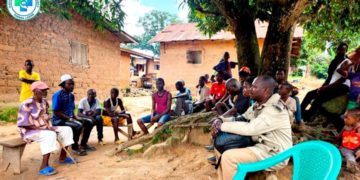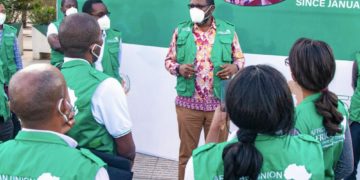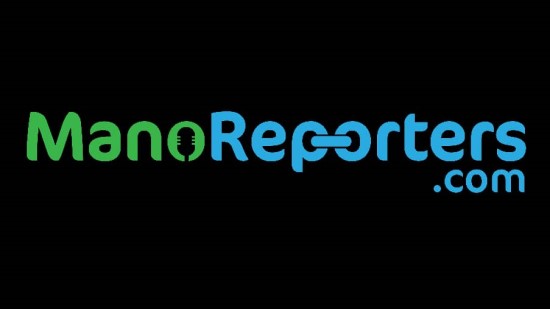By Kemo Cham
Originally Published by Down To Earth
Sierra Leone’s energy poverty, like other countries in the African continent, has compounded massively. Most of the country still depends on firewood for cooking fuel and its progress towards renewable shift is extremely slow.
Over 72 per cent of the population has no access to electricity and 99.2 per cent depend on unclean cooking fuel, found Tracking SDG7: The Energy Progress Report, 2023 by intergovernmental organisation International Energy Agency.
In Masanki, a small village near Mile 91, the third largest town in Sierra Leone’s northern Tonkolili District, majority of residents use fuelwood as source of energy for preparing meals. Residents like Isatu Fullah trek around five kilometres a day to fetch wood.
Overdependence on firewood has led to rampant deforestation in the country. Now, the locals are restricted from access to the remaining woods thanks to a logging company, leaving them with zero options.
A logging company, Miro Forestry, has acquired a huge portion of community lands for its business. Besides concerns over how the lands were acquired and unfulfilled promises to locals, residents are no longer allowed to access bushes — the only source of livelihood for many.
“About a decade ago, even my child could fetch fuelwood from the backyard. But now I find it difficult to get it,” said Fullah. The chore of fetching wood is mostly delegated to women, who travel long distances in groups for safety.
This status quo also means that the price of charcoal (wood burned until it is reduced to almost pure carbon, which burns longer and hotter) has gone up, placing it out of reach for most residents, in a country where over 60 per cent of the population lives below the national poverty line on less than $1.25 a day.
Before the arrival of Miro in 2012, a bag of charcoal in Masanki cost NLe 8 ($0.04). It’s now NLe 45 ($2.29). Charcoal is even more expensive in urban centres, especially in Freetown and its environs, where a bag can cost as much as NLe 80 ($ 4.07).
“We barely get food, we cannot afford to buy charcoal,” said Fullah. Her family of eight lives on subsistence farming.
As grim as this picture may seem, the situation of Fullah, a mother of three, is better than many of her neighbours in Masanki, where some people go to bed hungry for lack of wood to cook.
According to the International Trade Administration, 80 per cent of Sierra Leone’s population source energy from biomass, mainly wood. Yet it is an uphill task for many to access it, making the country home to one of the highest rates of energy poverty in the world.
At night, the villagers rely on dim, battery-powered Chinese lamps.
According to Sustainable Energy For All, an independent organisation that works with the United Nations, governments and private sector entities to fast track the attainment of UN-mandated Sustainable Development Goal-7, only 26 per cent of Sierra Leone’s population has access to electricity.
There is a huge gap between urban and rural populations in terms of access too. Only 55 per cent of the urban area and five per cent of the rural population are connected to the grid.
Reliability is also a major concern for those who are connected to the grid. In Jui, a town just outside the capital, Aminata Bangura recently had to dump groceries worth thousands of the local currency, New Leone, due to erratic power supply.
For three consecutive days, there was no electricity. “All the perishable stuff I had just purchased, like fish, chicken and meat, got spoiled,” Bangura said.
Electricity is also very expensive. A new set of tariffs took effect last July and it provoked widespread public anger, with calls for public protest.
At $0.082 per kilowatt hour for households and $0.109 U.S. Dollar for businesses, many claimed the rates are the highest among all of sub-Saharan Africa.
Sierra Leone has a single thermal power plan constructed to produce 27 megawatts, whose production capacity reduced drastically over the years. It’s complemented by several hydropower plants.
The shortage of energy has led to overreliance on polluting and expensive fossil fuels like diesel and petrol. Residents buy petrol to power their backup generators to provide a few hours of electricity per day.
But with the high cost of petroleum products, many generators have gone silent in the last three years as the economic crunch bites the population due to what officials attribute to the Russia-Ukraine crisis.
However, there has been some progress. When he assumed office in 2018, President Julius Maada Bio inherited just about 100 MW of electricity generating capacity, which catered for just about 10 per cent of the country’s over seven million population.
But a substantial part of that was wasted due to a decrepit transmission and distribution infrastructure.
As of 2022, the country generates about 180 MW. And the difference in terms of access has hardly changed, thanks to the poor transmission infrastructure. The Bio administration said it intends to complement the progress by leveraging the country’s renewable energy potential.
Already, a substantial portion of its limited generation capacity comes from hydropower, whose outputs can vary significantly by season.
Most of the remaining supply comes from foreign-owned offshore power vessels, whose operations are regularly interrupted by financial issues.
These ships produce an estimated 60 per cent of the country’s electricity during the dry season, and they burn heavy fuel oil or diesel, making them expensive, polluting and a continual drain on the country’s foreign reserves.
In mid-2022, most of Freetown was plunged into darkness for an extended period after the Turkish owned Karpowership shut down for unexplained reasons. It was later revealed in a World Bank report that they owed the government $36 million in unpaid arrears for a year.
Sierra Leone is tipped to have a high potential for clean energy, but lack of resources and prioritisation means it is unable to exploit them. However, a few projects are in progress, including collaborative initiatives with funding support from the country’s development partners.
The National Renewable Energy Action Plan recognises the potential of the country’s rivers to generate baseload hydropower as part of wider efforts to reduce dependency on fossil fuels.
The Bumbuna Hydroelectric Power Station is the country’s biggest power project. Located on the Seli River in central Tonkolili, construction work has been done in phases, since the plan was first unveiled in 1975.
The first phase, completed in 2009, was designed to produce 50 MW, costing an estimated $190 milliom. Commencement of work on the second phase was announced in 2011, with an estimated investment of $750 million and to produce an additional 350 MW capacity by 2017.
The latest estimates envisage completion of the project in 2027, with a production capacity of 145 MW. Insufficient water supply and recurrent technical problems means that the existing plant has always operated below its full capacity.
Phase two was meant to not just produce more power capacity, but also to provide continued electricity during the dry season with a larger water storage capacity.
A subregional initiative — the West African Power Pool project — also allows Sierra Leone, Guinea and Liberia to source electricity from fellow Mano River Union neighbour, Ivory Coast. That project has led to the construction of new transmission lines, which comes in handy for the revamped Bumbuna project.
In February, Sierra Leone was one of four countries, alongside Liberia, Togo and Chad, that benefitted from a $311 million World Bank-funded renewable energy project that entails the construction of around 106 MW of solar power generation capacity with battery energy and storage systems and 41 MW expansion of hydroelectric capacity.
At a ceremony marking the signing of that agreement, President Bio lamented the impact of the high cost of energy on the country. “We are paying far more for energy now than we were 18 months ago. Very high and rising energy prices continue to have an adverse impact on other sectors of our economies,” he said.
The government said all projects are designed not just to augment Sierra Leone’s energy access rate but also, in the long run, to displace carbon-intensive energy from diesel generators, as part of efforts to reduce greenhouse gas emissions and build resilience to climate change.
In its updated nationally determined contributions registry, Sierra Leone defined a progressive path forward for cutting greenhouse gases emissions from 2005 levels: 5 per cent by 2025, 10 per cent by 2030 and 25 per cent by 2050.
The country emitted 1.01 metric tonnes of carbon dioxide in 2021, according to the Emissions Database for Global Atmospheric Research of the European Commission.
Under an initiative by the Global Energy Alliance for people and planet, Bitgreen, a company building blockchain’s epicentre for sustainability and impact investment, is partnering with the infrastructure developer SERL and the International climate action platform to build the Betmai Hydroelectric Facility.
The estimated $10 million project is expected to provide some 500,000 Sierra Leoneans with renewable energy.
The 27 MW Betmai hydropower project is expected to produce 132 GWh of electricity every year, increasing the country’s power generation capacity by at least 10 percent and its renewable capacity by over 27 percent.
The company promises that after just five years of operation, the project is expected to cut emissions by at least 675,000 tons of CO2. “This is comparable to taking over 146,000 US passenger vehicles off the road for a year,” the company said.
Part of this article appeared in the cover story of the July 1-15, 2023 print edition of Down To Earth under the headline ‘Time Africa Switched’
